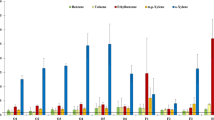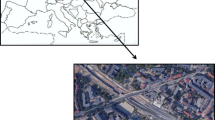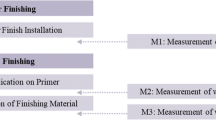Abstract
The aim of this study was to measure the level of indoor air pollutants (carbon dioxide [CO2], formaldehyde [HCHO], volatile organic compound [VOC)], and bacteria and fungi) in Water and Wastewater Engineering Laboratory (WWEL) (station 1) and Material Engineering Laboratory (MEL) (station 2) in a university building every 60 min. Measurements were taken over an 8-h period each day for 3 days. The results showed that the total volatile organic compounds (TVOCs) and respirable particulates exceeded the acceptable limits for indoor air quality (IAQ) set by the Department of Occupational Safety and Health (DOSH) in both locations. The concentration of formaldehyde measured at station 2 also exceeded the acceptable limit. Bacteria found in both laboratories were identified as gram-positive bacteria; the most dominant microbes were from Bacillus sp. A good ventilation system and a careful selection of construction materials are crucial to reduce IAQ contamination.

Similar content being viewed by others
References
Abdulaali HS, Hanafiah MM, Usman IMS, Nizam NUM, Abdulhasan MJ (2020) A review on green hotel rating tools, indoor environmental quality (IEQ) and human comfort. Int J Adv Sci Technol 29(03):128–157
Abt E, Suh HH, Allen G, Koutrakis P (2000) Characterization of indoor particle sources: a study conducted in the metropolitan Boston area. Environ Health Perspect 108:35–44
Ali MY, Hanafiah MM, Latif MT (2016) Composition and distribution of particulate matter (PM10) in a mechanically ventilated university building. In AIP Conference Proceedings, vol 1784, no. 1. AIP Publishing, pp 060017
Ali MY, Hanafiah MM, Khan MF, Latif MT (2017) Quantitative source apportionment and human toxicity of indoor trace metals at university buildings. Build Environ 121:238–246
Ali MY, Hanafiah MM, Khan MF (2018) Potential factors that impact the radon level and the prediction of ambient dose equivalent rates of indoor microenvironments. Sci Total Environ 626:1–10
Ashraf MA, Hanafiah MM (2019) Sustaining life on earth system through clean air, pure water, and fertile soil. Environ Sci Pollut Res 26:13679–13680
Bernstein JA, Alexis N, Bacchus H, Bernstein IL, Fritz P, Horner E, Li N, Mason S, Nel A, Oullette J (2008) The health effects of nonindustrial indoor air pollution. J Allergy Clin Immunol 121:585–591
Betha R, Behera SN, Balasubramanian R (2014) Southeast Asian smoke haze: fractionation of particulate-bound elements and associated health risk. Environ Sci Technol 48:4327–4335
Bjorn E, Nielsen PV (2002) Dispersal of exhaled air and personal exposure in displacement ventilated rooms. Indoor Air 12(3):147–164
Bomala K, Saramanda G, Reddy B, Kaparapu J (2016) Microbiological indoor and outdoor air quality Visakhapatnam City, India Int J Curr Res 8(4):29059–29062
Borrielo PS, Murray PR, Funke G, Topley and Wilson’s (2005) Microbiology And Microbial Infections: Bacteriology-1, 10th edn. American Society for Microbiology Press, Washington DC, pp 185–194
Bouillard L, Michel O, Dramaix M, Devleeschouwer M (2005) Bacterial contamination of indoor air, surfaces, and settled dust, and related dust endotoxin concentrations in healthy office buildings. Ann Agric Environ Med 12:187–192
Burge PS (2004) Sick building syndrome. Occup Environ Med 61:185–190
Daisey JM, Angell WJ, Apte MG (2003) Indoor air quality, ventilation and health symptoms in schools: an analysis of existing information. Indoor Air 13(1):53–64
Department of Occupational Safety and Health (DOSH) (2010) Industry code of practices (ICOP) on indoor air quality. Ministry of Human Resources, Putrajaya
Emojevwe V, Okeremeta O, Loveth (2013) Aerial microbiology of the science building (ofrima complex) in the university of Port Harcourt. Adv Agri Sci Eng Res 3:809–815
Environment Protection Agency (EPA) (2003) Indoor air quality tools for schools IAQ coordinator’s guide. US Environmental Protection Agency, pp 1–78
EPA (2005) Office of Air Quality Planning and Standards. Review of the National Ambient Air Quality Standards Particulate Matter: Policy Assessment of Scientific and Technical Information
Fleischer M, Bober-Gheek B, Bortkiewicz O, Rusiecka-Ziólkowskaa J (2006) Microbiological control of airborne contamination in hospitals. Indoor Built Environ 15:53–56
Fromme H, Twardella D, Dietrich S, Heitmann D, Schierl R, Liebl B, Rüden H (2007) Particulate matter in the indoor air of classrooms—exploratory results from Munich and surrounding area. Atmos Environ 41(4):854–866
Gilbert NL, Gauvin D, Guay M, Héroux ME, Dupuis G, Legris M, Chan CC, Dietz RN, Lévesque B (2006) Housing characteristics and indoor concentrations of nitrogen dioxide and formaldehyde in Que’bec City, Canada. Environ Res 102:1–8
Gorny RL (2004) Filamentous microorganisms and their fragments in indoor air: a review. Ann Agric Environ Med 11:185–197
Gorny RL, Dutkiewicz J (2002) Bacterial and fungal aerosols in indoor environment in central and eastern European countries. Ann Agric Environ Med 9:17–23
Graudenz GS, Oliveira CH, Tribess A, Mendes C Jr, Latorre MR, Kalil J (2005) Association of air conditioning with respiratory symptoms in office workers in tropical climate. Indoor Air 15:62–66
Gudmundsson A, Londahl J, Bohegard M (2007) Methodology for identifying particle sources in indoor environments. J Environ Monit 9:831–838
Hayleeyesus SF, Manaye AM (2014) Microbiological quality of indoor air in university libraries. Asian Pac J Trop Biomed 4:S312–S317
Hitchins J, Morawska L, Gilbert D, Jamriska M (2002) Dispersion of particles from vehicle emissions around high and low-rise buildings. Indoor Air 12:64–71
Hospodsky D, Qian J, Nazaroff WW, Yamamoto N, Bibby K, Rismani-Yazdi H, Peccia J (2012) Human occupancy as a source of indoor airborne bacteria. PLoS One 7:e34867
Hou Y, Liu J, Li J (2015) Investigation of indoor air quality in primary school classrooms. Procedia Eng 121:830–837
Howard-Reed C, Wallace LA, Emmerich SJ (2003) Effect of ventilation systems and air filters on decay rates of particles by indoor sources in an occupied townhouse. Atmos Environ 37(38):5295–5306
Hussin NHM, Sann LM, Shamsudin MN, Hashim Z (2011) Characterization of bacteria and fungi bioaerosol in the indoor air of selected primary schools in Malaysia. Indoor Built Environ 20(6):607–617
Idris SAA, Hanafiah MM, Khan MF, Hamid HHA (2020) Indoor generated PM2.5 compositions and volatile organic compounds: potential sources and health risk implications. Chemosphere 255:126932
Ilgen E, Karfich N, Levsen K, Angerer J, Schneider P, Heinrich J, Wichmann H, Dunemann L, Begerow J (2001) Aromatic hydrocarbons in the atmospheric environment: part I. Indoor versus outdoor sources, the influence of traffic. Atmos Environ 35:1235–1252
Jamriska M (2000) Effect of ventilation and filtration on submicrometer particles in an indoor environment. Indoor Air 10(1):19–26
Jarraud S, Mougel C, Thioulouse J, Lina G, Meugnier H, Forey F, Vandenesch F (2002) Relationships between Staphylococcus aureus genetic background, virulence factors, agr groups (alleles), and human disease. Infect Immun 70(2):631–641
Jo WK, Lee JY (2006) Indoor and outdoor levels of respirable particulates (PM10) and carbon monoxide (CO) in high-rise apartment buildings. Atmos Environ 40(32):6067–6076
Khan MF, Shirasuna Y, Hirano K, Masunaga S (2010) Characterization of PM2.5, PM2. 5–10 and PM>10 in ambient air, Yokohama, Japan. Atmos Res 96(1):159–172
Liqun G, Yanqun G (2011) Study on building materials and indoor pollution. Procedia Eng 21:789–794
Long CM, Suh HH, Koutrakis P (2000) Characterization of indoor particle sources using continuous mass and size monitors. J Air Waste Manage Assoc 50:1236–1250
Mahboubi A, Koushik A, Siemiatycki J, Lavoué J, Rousseau MC (2013) Assessment of the effect of occupational exposure to formaldehyde on the risk of lung cancer in two Canadian population-based case—control studies. Scand J Work Environ Health 39:401–410
Makut M, Nyam M, Shehu A, Anzaku S (2014) A survey of the microflora in outdoor air environment of Keffi Metropolis, Nasarawa state, Nigeria Acad J 8(27):2650–2655
Mandal J, Brandl H (2011) Bioaerosols in indoor environment - a review with special reference to residential and occupational locations. Open Environ Biol Monitor J 4:83–96
Meadow JF, Altrichter AE, Kembel SW, Kline J, Mhuireach G, Moriyama M, Northcutt D, O'Connor TK, Womack AM, Brown GZ, Green JL, Bohannan BJM (2014) Indoor airborne bacterial communities are influenced by ventilation, occupancy, and outdoor air source. Indoor Air 24(1):41–48
Mirhoseini SH, Nikaeen M, Satoh K, Makimura K (2016) Assessment of airborne particles in indoor environments: applicability of particle counting for prediction of bioaerosol concentrations. Aerosol Air Qual Res 16(8):1903–1910
Morawska L, Afshari A, Bae GN, Buonanno G, Chao CYH, Hänninen O, Salthammer T (2013) Indoor aerosols: from personal exposure to risk assessment. Indoor Air 23(6):462–487
Moschandreas DJ, Pagilla KR, Storino LV (2003) Time and space uniformity of indoor bacteria concentrations in Chicago area residences. Aerosol Sci Technol 37:899–906
Ogulei D, Hopke PK, Wallace LA (2006) Analysis of indoor particle size distributions in an occupied townhouse using positive matrix factorization. Indoor Air 16:204–215
Okafor EC, Opuene K (2007) Preliminary assessment of trace metals and polycyclic aromatic hydrocarbons in the sediments. Int J Environ Sci Technol 4(2):233–240
Ott WR, Steinemann AC, Wallace LA (2007) Exposure analysis. CRC Taylor and Francis Group, New York ISBN 1 56670 663 7
Pegas PN, Alves CA, Evtyugina MG, Nunes T, Cerqueira M, Franchi M, Freitas MC (2011) Indoor air quality in elementary schools of Lisbon in spring. Environ Geochem Health 33(5):455–468
Pérez-Padilla R, Schilmann A, Riojas-Rodriguez H (2010) Respiratory health effects of indoor air pollution. Int J Tuberc Lung Dis 14(9):1079–1086
Qian J, Hospodsky D, Yamamoto N, Nazaroff WW, Peccia J (2012) Size-resolved emission rates of airborne bacteria and fungi in an occupied classroom. Indoor Air 22:339–351
Sahu V, Elumalai SP, Gautam S, Singh NK, Singh P (2018) Characterization of indoor settled dust and investigation of indoor air quality in different micro-environments. Int J Environ Health Res 28(4):419–431
Salthammer T, Mentese S, Marutzky R (2010) Formaldehyde in the indoor environment. Chem Rev 110(4):2536–2572
Soto T, Murcia RM, Franco A, Vicente-Soler J, Cansado J, Gacto M (2009) Indoor airborne microbial load in a Spanish university (University of Murcia, Spain). An Biol 31:109–115
Tanha MR, Hanafiah MM, Khalid FR, Storai MA, Hoeschen C (2020) Current status of radioactive waste management in Afghanistan. J Radioanal Nucl Chem 323:715–720
Toivola M (2004) Personal exposure to microbial aerosols. Doctoral dissertation, Publications of the National Public Health Institute A13
Toivola M, Nevalainen A, Alm S (2004) Personal exposures to particles and microbes in relation to micro-environmental concentrations. Indoor Air 14:351–359
Tsai FC, Mache JM (2005) Concentrations of airborne culturable bacteria in 100 large US office buildings from the BASE study. Indoor Air 15:71–81
U.S. Environmental Protection Agency (2010) Toxicological review of formaldehyde inhalation toxicity (External Review Draft): In support of summary information on the Integrated Risk Information System (IRIS). EPA/635/R- 10/002A. http://cfpub.epa.gov/ncea/iris_drafts/recordisplay.cfm?deid=223614
Udosen CI, Essien JP, Umana SI, Ekong UE, Nkanang AJ (2018) Microbiological properties and population dynamics of atmosphere in Mesotidal Estuarine of Iko River, Akwa Ibom State, Nigeria J Adv Biol Biotech 17(4):1–19
Umana S, Edet N, Uko M, Agbo B, Bassey M (2019) Microbiological quality of indoor and outdoor air within biological sciences Laboratories in Akwa Ibom State University, Nigeria. Frontiers in Environmental Microbiology 4(6):124
Venkateswaran K, Hattori N, La Duc MT, Kern R (2003) ATP as a biomarker of viable microorganisms in clean-room facilities. J Microbiol Methods 52(3):367–377
Waites MJ, Morgan NL, Rockey JS, Highton G (2009) Industrial microbiology an introduction. Blackwell Publisher, London
Wallace LA, Emmerich SJ, Howard-Reed C (2004) Effect of central fans and in-duct filters on deposition rates of ultrafine and fine particles in an occupied townhouse. Atmos Environ 38(3):405–413
Wang Z, Shalat SL, Black K, Lioy PJ, Stamper AA, Emoekpere OH, Hernandez M, Han T, Ramagopal M, Mainelis G (2012) Use of robotic sampling platform to assess young children’s exposure to indoor bioaerosols. Indoor Air 22:159–169
Yang W, Sohn J, Kim J, Son B, Park J (2009) Indoor air quality investigation according to age of the school buildings in Korea. J Environ Manag 90(1):348–354
Yassin MF, Almouqatea S (2010) Assessment of airborne bacteria and fungi in an indoor and outdoor environment. Int J Environ Sci Technol 7(3):535–544
Acknowledgments
We would like to thank the University Malaysia Terengganu for providing facilities to conduct this study.
Funding
Marlia M. Hanafiah was funded by the Ministry of Education Malaysia (FRGS/1/2018/WAB05/UKM/02/2) and UKM research grants (KRA-2018-054 and DIP-2019-001).
Author information
Authors and Affiliations
Corresponding author
Additional information
Responsible Editor: Amjad Kallel
Rights and permissions
About this article
Cite this article
Idris, S.A.‘., Hanafiah, M.M., Ismail, M. et al. Laboratory air quality and microbiological contamination in a university building. Arab J Geosci 13, 580 (2020). https://doi.org/10.1007/s12517-020-05564-8
Received:
Accepted:
Published:
DOI: https://doi.org/10.1007/s12517-020-05564-8




